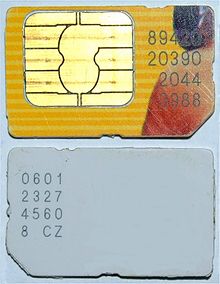Software and applications
See also: Mobile Industry Processor Interface
The most commonly used data application on mobile phones is SMS text messaging. The first SMS text message was sent from a computer to a mobile phone in 1992 in the UK, while the first person-to-person SMS from phone to phone was sent in Finland in 1993.
The first mobile news service, delivered via SMS, was launched in Finland in 2000. Mobile news services are expanding with many organisations providing "on-demand" news services by SMS. Some also provide "instant" news pushed out by SMS.
Power supply
Mobile phone charging service in Uganda
Mobile phones generally obtain power from rechargeable batteries. There are a variety of ways used to charge cell phones, including USB, portable batteries, mains power (using an AC adapter), cigarette lighters (using an adapter), or a dynamo. In 2009, the first wireless charger was released for consumer use.[11]
Development and adoption of a Common Charger Solution for cell phones
Main article: common External Power Supply
On 17 February 2009, the GSM Association (GSMA), together with 17 cell phone manufacturers and providers, announced[12] their commitment to implementing a cross-industry standard for a universal charger for new mobile phones. The standard charger connector to be adopted by manufacturers in the Open Mobile Terminal Platform (OMTP) including Nokia, Motorola and Samsung is the micro-USB connector (several media reports erroneously reported this as the mini-USB). The new chargers will also be much more energy efficient than existing chargers. Having a standard charger for all phones, means that manufacturers will no longer have to supply a charger with every new phone.
In June 2009, many mobile phone manufacturers signed a Memorandum of Understanding (MoU), agreeing to make most new data-enabled cell phones marketed in the EU compatible with a common External Power Supply (charger) which will be equipped with a Micro-USB connector. All signatories agreed to develop a common specification for the charger "to allow for full compatibility and safety of chargers and mobile phones."[13][14] The mobile phone manufacturers who have agreed to this standard include the original signatories Apple, LG, Motorola, NEC, Nokia, Qualcomm, RIM, Samsung, Sony Ericsson, and Texas Instruments as well as Atmel, Emblaze Mobile, Huawei Technologies and TCT Mobile (Alcatel).
In October 2009, the International Telecommunication Union (ITU) announced that it had also embraced the Universal Charger Solution standard - based on input from the GSMA - as its "energy-efficient one-charger-fits-all new mobile phone solution," and added: "Based on the Micro-USB interface, UCS chargers will also include a 4-star or higher efficiency rating — up to three times more energy-efficient than an unrated charger."[18]
Charger efficiency
The majority of energy lost in a mobile phone charger is in its no load condition, when the mobile phone is not connected but the charger has been left plugged in and using power. To combat this, in November 2008, the top five mobile phone manufacturers Nokia, Samsung, LG, Sony Ericsson, and Motorola set up a star rating system to rate the efficiency of their chargers in the no-load condition. Starting at zero stars for >0.5 W and going up to the top five star rating for <0.03 W (30 mW) no load power.[19]
A number of semiconductor companies offering flyback controllers, such as Power Integrations and CamSemi, now claim that the five-star standard can be achieved with use of their product.[20]
Battery
Formerly, the most common form of mobile phone batteries were nickel metal-hydride, as they have a low size and weight. Lithium ion batteries are sometimes used, as they are lighter and do not have the voltage depression that nickel metal-hydride batteries do. Many mobile phone manufacturers have now switched to using lithium-polymer batteries as opposed to the older Lithium-Ion, the main advantages of this being even lower weight and the possibility to make the battery a shape other than strict cuboid.[21] Mobile phone manufacturers have been experimenting with alternative power sources, including solar cells.
[edit] SIM card
| This section needs additional citations for verification. Please help improve this article by adding reliable references. Unsourced material may be challenged and removed. (September 2009) |
Main articles: Subscriber Identity Module and Removable User Identity Module

Typical mobile phone SIM card
GSM mobile phones require a small microchip called a Subscriber Identity Module or SIM Card, to function. The SIM card is approximately the size of a small postage stamp and is usually placed underneath the battery in the rear of the unit. The SIM securely stores the service-subscriber key (IMSI) used to identify a subscriber on mobile telephony devices (such as mobile phones and computers). The SIM card allows users to change phones by simply removing the SIM card from one mobile phone and inserting it into another mobile phone or broadband telephony device.

